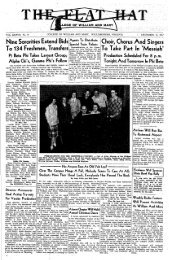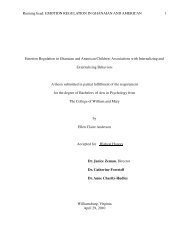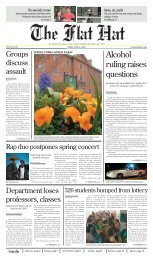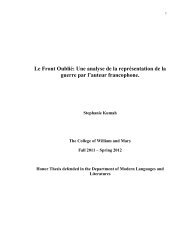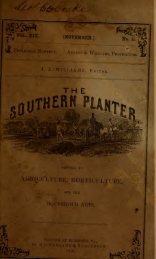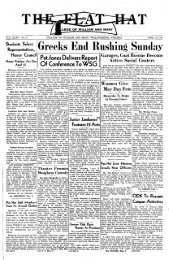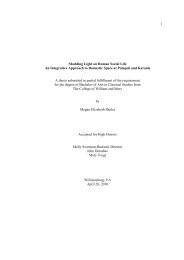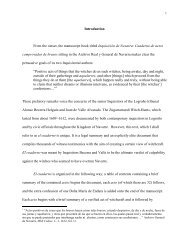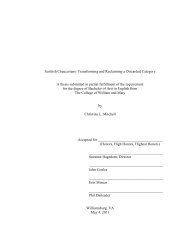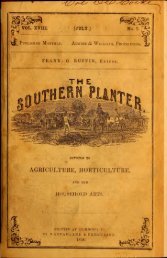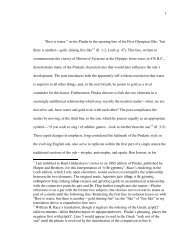Southern planter - The W&M Digital Archive
Southern planter - The W&M Digital Archive
Southern planter - The W&M Digital Archive
You also want an ePaper? Increase the reach of your titles
YUMPU automatically turns print PDFs into web optimized ePapers that Google loves.
1908.] THE SOUTHERN PLANTER. 23<br />
prices for the foodstuffs utilized. On the other hand,<br />
cattle handled as stockers will produce a considerable<br />
quantity of manure and may be made to consume cheap<br />
forms of roughness made on the farm, will make large<br />
seed meal group, 1.80 pounds; the corn and cob meal and<br />
cotton seed meal group, 1.81 pounds, and the corn meal<br />
and cotton seed meal group, 1.73 pounds. <strong>The</strong>se results<br />
were affected but little by the hogs following the cattle,<br />
Prize-Winning Red Poll Herd, Virginia State Fair, 1907. Owned by George Ineichen & Sons, Geneva, Ind.<br />
profits on a margin of 50 cents, and will even make fair<br />
profits on a margin of 25 cents, when pasture is charged<br />
to them at the rate of $1.25 per acre.<br />
<strong>The</strong>se facts are such as to justify us in recommending<br />
farmers generally to build silos and utilize silage in their<br />
winter feeding operations for practically all classes of cat-<br />
tle, as we believe it can be fed to advantage to calves<br />
and yearlings and cattle to be finished either in the stall<br />
or on grass. <strong>The</strong> construction of a silo is not a costly<br />
operation and it furnishes food for several months in the<br />
cheapeast and easiest form to handle and convey to live<br />
stock. It is palatable, easy of digestion and assimilation<br />
and is highly relished by all classes of live stock. It is<br />
made from a crop that is more widely cultivated than any<br />
other in America and solves the difficult problem of securing<br />
satisfactory substitutes for grass in sections where<br />
the latter does not thrive well. <strong>The</strong> results, taken all in<br />
all, justify the high value we have placed on silage, and it<br />
is believed that its extensive utilization will result in<br />
revolutionizing the animal industry of the South.<br />
Conclusions.<br />
1. <strong>The</strong> results of the trials presented in this report<br />
coincide quite closely with those of previous investigations<br />
and emphasize more than ever the importance of grass as<br />
an adjunct in finishing cattle in the Appalachian region.<br />
2. <strong>The</strong> results substantiate our previous claims of the<br />
high feeding value of silage and justify us in urging farm-<br />
ers in the South to utilize iit more extensively as a rough-<br />
ness for cattle which are to be finished in the stall or car-<br />
ried through the winter as stockers and fattened on grass.<br />
3. Owing to the laxative tendency of silage, it has been<br />
found advisable to feed a small amount of dry roughness.<br />
From two to three pounds of shredded stover or timothy<br />
hay have proven ample and, in view of the gains secured,<br />
we would not advise the use of larger amounts when the<br />
silage is of first class quality.<br />
4. <strong>The</strong> gains per head per day for the stall fed cattle<br />
were quite satisfactory. <strong>The</strong> ear corn and cotton seed<br />
meal group made 1.66 pounds per head per day for the<br />
entire period of 149 days; the shelled corn and cotton<br />
which indicates that when a ration of concentrates is<br />
properly adjusted there will not be much waste.<br />
5. <strong>The</strong>re was enough difference in the gains obtained in<br />
this experiment to justify shelling the corn, but it is a<br />
question whether the practice would be profitable one year<br />
with another. <strong>The</strong> gains from corn meal and corn and cob<br />
meal were practically the same as those obtained from<br />
whole corn, and would not justify the expense incident to<br />
grinding the grain.<br />
6. It is again noteworthy that though the cattle consumed<br />
approximately three pounds of cotton seed meal<br />
per head per day the health of the hogs following them<br />
was not affected in any way.<br />
7. In order to secure a fair profit from the stall feed-<br />
ing of beef cattle when no consideration is taken of the<br />
manure, it would be necessary to have a margin of at<br />
least $1.00 at the prevailing prices charged for the food-<br />
stuffs in this trial.<br />
8. It has generally been thought that silage fed cattle<br />
would shrink badly when shipped long distances. <strong>The</strong><br />
actual loss per individual on the cattle shipped to Jersey<br />
City was 41.2 pounds, whereas, practical shippers from<br />
this section estimate the average shrinkage at from sixty<br />
to seventy pounds.<br />
9. As this lot of cattle dressed out 56.9 per cent, of meat<br />
of fine quality in which the fat and lean were well<br />
blended and equal to that from Western bullocks fed on<br />
corn, there is no justification for the opposition to the<br />
use of silage for the finishing of. beef cattle.<br />
10. Of the cattle fed as stockers, the group receiving<br />
straight silage made 1.06 pounds of gain per head per day;<br />
the hay group, .27 of a pound; the stover group, .08 of a<br />
pound, and the silage and grain group, 1.22 pounds. When<br />
placed on pasture the silage fed group made an average<br />
gain per head per day of 1.91 pounds; the hay fed group<br />
2.19 pounds; the stover group, 2.85 pounds, and the silage<br />
and grain group, 1.58 pounds.<br />
11. <strong>The</strong> average results of both stall feeding and graz-<br />
ing show that the silage fed group made a gain of 1.43<br />
pounds per head per day; the hay group, 1.11 pounds; the



